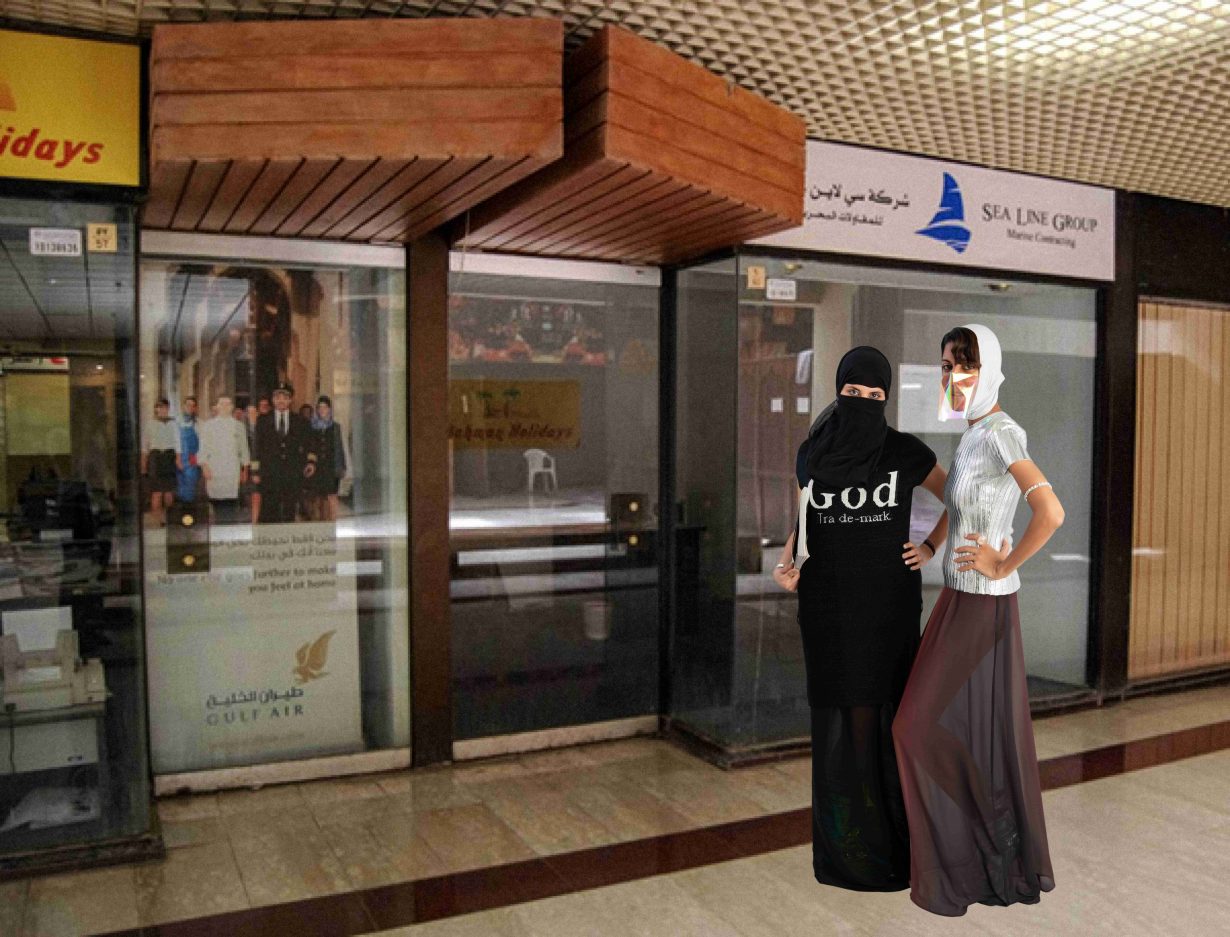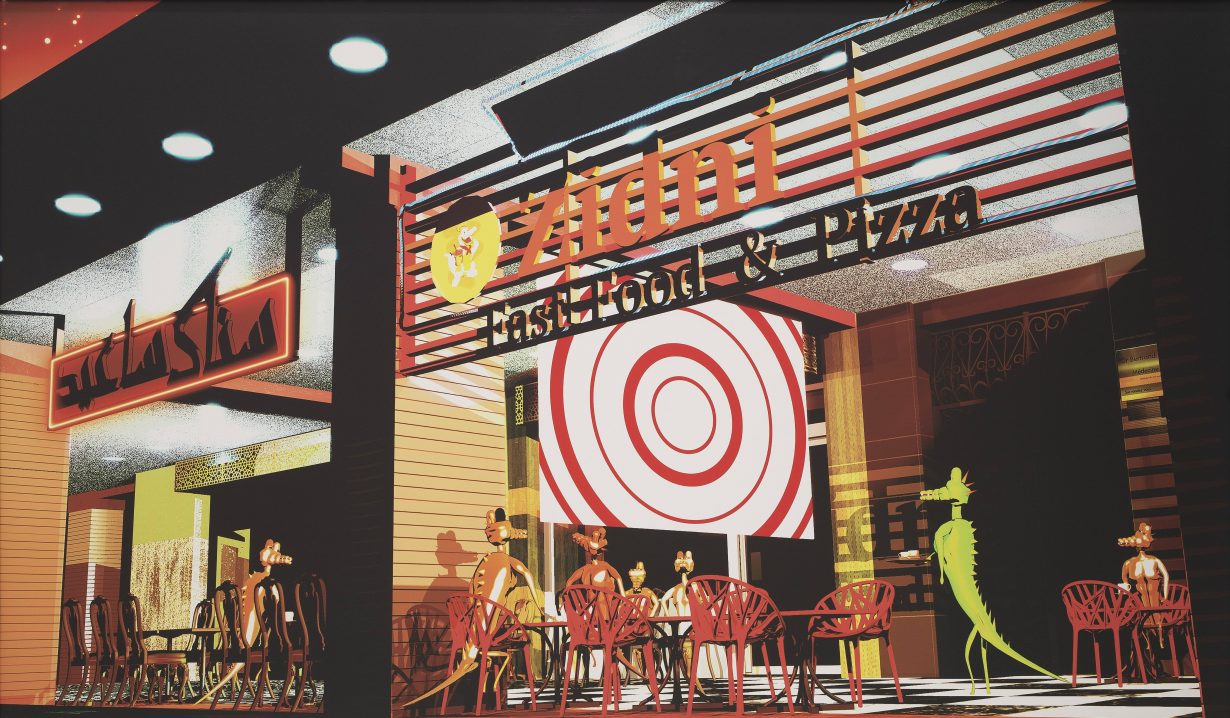What happens when the seductive aesthetics of futurism overtake the movement’s more radical ambitions?
In the exhibition ARABOFUTURS, the Institut du Monde Arabe (IMA) surveys Arabfuturism – understood as an attempt by Arab artists to imagine the future and belonging against Orientalist narratives through sci-fi themes. From the outset, the framing and curation of ARABOFUTURS stimulates historical and contemporary parallels to its progenitor Afrofuturism. The latter, with roots in African American science-fiction, contains strong communal and diasporic dimensions across art, literature and music. In Afrofuturism, Black universes break narrative limitations to occupy dreamscapes that allow African Americans and the Black diaspora to thrive together rather than merely survive as disconnected kin. Despite the clear lineage between the two movements, the Arabfuturism presented here foregoes the ambitious and radical dimensions of liberation that could have proposed a new cultural pan-Arabism.
This fuzzy, more recent notion of Arabfuturism is explored in ARABOFUTURS through a variety of media – film, videogame, sculpture, photography and painting. The show opens with a collaborative work by Sophia Al-Maria and Fatima Al Qadiri, proponents of what they term ‘Gulf Futurism’, situated within the broader reaches of Arabfuturism. Their photo series The desert of the unreal (2012) – a riff on Jean Baudrillard’s ‘desert of the real’ to describe the hyperrealism of 1980s American pop culture – reflects what the two artists have described as the socioeconomic transformations of Gulf countries since the discovery of oil, and the tension these changes have generated in society with a toggle between tradition and modernity. We can distinguish in the photos of covered women in empty malls and other commercial spaces a postmodern blues, what they call a ‘naïve optimism’ resting on two mirages that characterise most Gulf states today: the sustainability of oil extraction and of hyperconsumerism.

A sense of disembodiment is woven into a film and console-driven segment midway in the show, in which avatars and posthuman landscapes gamify alternative futures. In these various narrative capsules, artists want to portray Arabness in diverse, proud, and shifting yet enduring terms. For example, in Sara Sadik’s film 2ZDZ (2019) she channels clichés of French North-African urban subculture in clothing and language as she introduces the ‘NoGoZoneXperience’, a virtual reality studio specializing in the simulation of dangerous environment. An off-limits, formerly abandoned oasis reclaimed by North Africans is conjured, symbolising the image of an idealised anti-banlieue. Another section of ARABOFUTURS recognises yet rejects erasure by introducing imaginary archaeologies as an alternative reality. This is the case with Larissa Sansour who collaborated with scriptwriter Søren Lind to produce their gripping, essayistic videowork In the Future They Ate From the Finest Porcelain (2016), a meditation and political manifesto on Palestinianhood that imagines an underground resistance group which makes deposits of elaborate porcelain in the ground to suggest an entirely fictional pre-civilization. Combining sci-fi, myth-making and collective affirmation, the video illuminates the Palestinian peoples’ aspiration for recognition and explores how history is mutable and open to invention. It communicates seamlessly with Aïcha Snoussi’s reimagined lost civilisation through the display of excavated fragments in Chaos Archéologie, ١ , ٢ ,٣ (2022).

Most Afrofuturists subverted common tropes and addressed Afro-American concerns from the vantage point of oppression and freedom, shaping, for example, worlds in which white colonisation didn’t exist. ARABOFUTURS’s rendition, however, minimises this revolutionary trait by juxtaposing works emanating from different and sometimes opposing positionalities, even though the many artists represented hail from a broad Arab diaspora. Conversations about race here are muted. The dominant voice of Gulf Arabs, from societies composed of up to 90 percent foreign nationals, speaks to very different concerns than French North Africans or beurs relegated to a status of conditional, subaltern citizens regularly threatened by the ebbs and flows of systemic racism. The latter are peripheral and marginal in that their diasporic lives exist in the crevices of the French Republic, as opposed to Gulf Arabs benefiting from political privilege and relative economic wealth. By promoting a kaleidoscopic approach to Arabfuturism, the show tends to flatten the importance of contextualisation. Sara Sadik’s urban visual language of ‘beurcore’ clashes with Al-Maria and Al-Qadira’s more polished perspective on the Gulf in more ways than only pictorial.
In that sense, despite several standout works ARABOFUTURS suffers as a result of its exalting the aesthetics of futurism applied to an Arab context at the expense of anchoring its politics. The retrofuturist flying cars, chic abayas, extraterrestrial objects and spatial conquests populate the show as signifiers of materialistic projections. Yet the future as a form of uchronia is also a significant site of social critique. The artists’ visions largely inform their view of the past and present and, here, it is largely preoccupied with representation without systematically unpacking power, save for Sansour and Lind who do so explicitly.

ARABOFUTURS also feels linear, where science and technology are posited as the material response to science-fiction, as if to suggest that fiction here can be folded seamlessly into reality. The show’s press release sets science-fiction as a ‘preferred tool’ to interrogate the future, while lauding the role of Arabs in science and technology, including Rayyanah Barnawi, who last year became the first female Arab astronaut to voyage in space. These achievements are celebrated while remaining silent on the military-security-industrial complex that enables mass surveillance and human rights violations in a region afflicted by democratic reversals, wars and humanitarian catastrophes. Grand projects such as Saudi Arabia’s Neom and policies including pervasive social media monitoring continue to harass activists, opposition and human rights defenders. Presenting science as a neutral, creative device hollows the ways in which it has been weaponized as an imperial experiment. There’s perhaps little surprise in that a country sending an Arab probe to Mars is also the same that militarily supports ongoing atrocities in Sudan, but this continuum is seldom addressed.
The IMA was established as a result of a partnership between France and countries from the Arab League. The show – which features Skyseeef’s sleek-looking photographs of floating cars – is sponsored by oil giant TotalEnergies, which is facing a lawsuit currently for its alleged environmental and human damage in Yemen. Though the vibrant images, such as Skyseeef’s, communicate at the intersection of design, fashion and conceptual art, their glossy composition underscores a deeper dissonance. ‘The Arab world moves, does its revolution, turning yet ever quickly and closer to the sun of innovation,’ writes 84-year-old IMA President Jack Lang in the show’s press package. It’s an appealing image, if the Middle East and North Africa were not the only region where poverty increased in the past decade, with the ebullience of early 2010s revolutions long suppressed. Such institutional magical thinking can be unsettling if, like me, you may have watched countless videos the same day of dismembered Arab children in the Gaza strip amidst posts for various GoFundMe campaigns.

Institutions like the IMA favour blockbuster shows, which generally call for a simplified message. Arabs dream of space and interrogate ways to inhabit the present through the lens of the future, but ‘Gulf Futurism’ did not originate with Al-Maria and Al Qadiri as it is suggested in the show. This narrative minimises the contributions of early ‘petrofiction’ literature, such as in the works of Saudi author Abdel Rahman Munif in the 1980s. In many ways, the show’s unevenness and, at times, cacophony underscores the indefinability of Arabfuturism, which can be conceived as an avatar for incessant ruminations on loss. What the IMA thinks it’s showing – emancipation through fictional futures connecting a vast diaspora – unintentionally points to its own limitations. Lebanese writer Samir Kassir wrote in Being Arab (2004) about an Arab ‘misfortune’ concerning an inability to distance from the idea of a more glorious past and its fall, a judgment that resonates strongly in the show. The ‘futurism’ presented by the IMA is more a continuation of an existing space-time, rather than an exhaustive attempt to collapse, collide or overstretch temporalities, geographies and sovereignties. Vague nostalgia binds the show’s survey of Arab dispossession and alienation, a weight that doesn’t drive forward but keeps one in stasis with a spacesuit.
As such, it’s a missed opportunity. Etel Adnan’s book-length poem Arab Apocalypse (1989) offered to transcend poetics of desolation by asking us to consider where ghosts should reside. ‘in the night in the night we shall find knowledge love and peace’, Adnan wrote, in new homes we are yet to imagine.
Farah Abdessamad is a French Tunisian writer based in New York City
